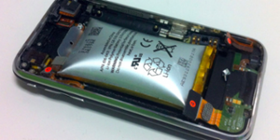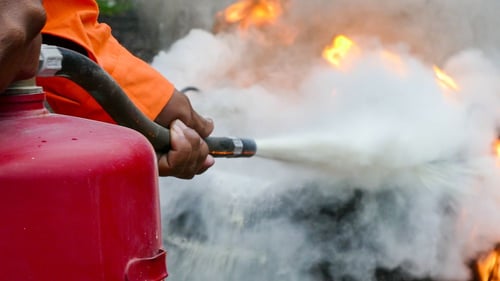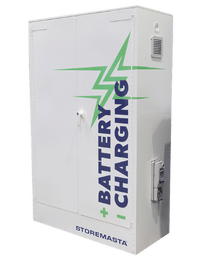It’s safe to say that your workplace probably has some lithium-ion (Li-ion) batteries onsite. From forklifts and drills to laptops and mobile phones, Li-ion batteries are found in a range of products and are an essential energy source for many industries. However, it’s important to consider how to safely charge your stores of lithium-ion batteries to avoid incidents such as thermal runaway, fire and explosion. If batteries are damaged, overheated, overcharged or unstable, they can quickly ignite and cause widespread damage to your workplace, as well as the surrounding environment. In this blog, we highlight some simple safety tips that you can apply to your own workplace to reduce risk when charging Li-ion batteries.
Inspect Your Batteries
Have you seen a leaking, swollen, dented or otherwise damaged lithium-ion battery? One of the most crucial things you can do to reduce risk is to always inspect your stores of Li-ion batteries.
Damaged batteries should never be put on charge, as this could cause the battery cell to erupt and ignite. Batteries should always be carefully handled, stored, charged and discharged to avoid any damage occurring. If your Li-ion batteries require maintenance, make sure you schedule this at regular intervals. Preserving the quality of your lithium-ion battery is one of the most important things you can do to minimise the risk of fire.
Discard Old Batteries
Lithium-ion batteries, while an economical and effective battery type, aren’t designed to last forever. While the limit varies, many lithium-ion batteries will have a certain amount of recharging and discharging cycles. Many batteries have a lifespan of around 5 years, however, this varies with the manufacturer, the type of battery you have, and how often it is charged and used in the workplace.

Aged, damaged or swollen batteries can cause serious damage to your workplace if they are not discarded in a safe manner.
When you notice aged batteries in your workplace, follow the procedures for the safe disposal of these items. Lithium-ion batteries can be extremely volatile products which can result in an exothermic reaction if there is extreme heat, a short circuit, a high charging voltage or physical damage to the battery. Therefore, you must never dispose of lithium-ion batteries in your usual waste disposal method, as this could cause fire, pollution and human harm.
Check with your local lithium-ion battery recycler to see if you can repurpose your old batteries and reduce waste in the most eco-friendly way.
Check the Temperature
Li-ion batteries are notoriously sensitive to heat and therefore must be charged and stored in an environment that is within a safe working temperature. Battery charging cabinets with ventilation systems and temperature control features can minimise the risk of the battery overheating and sparking a lithium-ion battery fire.
Choose a cool, dry and well-ventilated space to charge and store your Li-ion batteries.
Never charge batteries in direct sunlight, outdoors or near any type of hot work, heated surface, open flame or ignition source. The environment in which you charge your batteries should also be free from extreme humidity, as any moisture in the air or environment can also affect the stability of your lithium-ion battery.
Select a Safe Surface
While many of us have thrown our phone on the bed or floor to charge, when you’re working with lithium-ion batteries you should never charge them on a soft surface. Furniture, car seats and other soft surfaces can assist with heat generation, which may add to the risk of a lithium-ion battery fire. A metal surface is an ideal area to charge your phone, as long as it’s located in a cool, dry environment. Also make sure that your battery won’t get knocked off the bench while it’s charging, as this could permanently damage your battery and increase the risk of the cell malfunctioning upon its next charge.
Choose Your Charger
The manufacturer’s specifications for your lithium-ion batteries should include details on the type of battery charger that you should use. Selecting a quality charger that meets the national safety regulations of Australia is a safer option than choosing a cheaper imported model. Remember, your charger should match your Li-ion battery in output voltage and Ah rating.
Always take the time to read the instructions from your battery manufacturer to ensure that you’re using the right charger — and recharging your battery in the correct way. You should also create procedures for your staff to follow, so everyone handling and charge the Li-ion batteries are fully aware of the correct charging practices.
Consider the State of Charge
The state of charge of your lithium-ion batteries is an important factor to consider before you store or recharge your supplies. Recharging and discharging your battery from 100% to 0% is not an ideal way to maintain the lifespan and effectiveness of your battery. Using partial-discharge cycles and not charging to full capacity can keep your lithium-ion batteries working better for longer.
On the other hand, keeping a Li-ion battery in storage for long periods of time can also reduce the lifespan and battery capacity. Check with the battery manufacturer for further details about the ideal state-of-charge for your stores of Li-ion batteries.
Monitor Your Battery Charging
As we’ve just touched on, overcharging your Li-ion batteries is recognised as an unsafe practice. This is because the battery may suffer damage if a continuous volage is applied to the cell, after it’s already 100% charged. If the internal lithium metal plating develops a short circuit, your battery can overheat and spark a fire or explosion.
As lithium-ion batteries can be charged intermittently or receive a partial charge, you can avoid the hazards associated with overcharging. By choosing the correct charger and monitoring your discharge and charging cycles, you can improve the safety and performance of your Li-ion batteries.
Why Is Certified Electrical Work Important?
Lithium-ion batteries require stable electrical currents to prevent the battery cells from becoming unstable and causing a fire. Therefore, you should be careful to avoid high charge and discharge currents when you’re charging your Li-ion batteries. You should also have all electrical work ticked off by a licensed electrician to reduce the risk of faulty wiring.
Choosing a battery charging cabinet with electrical work compliant to Australian Standards is an important risk control measure that can improve safely during the charging process.

To avoid incidents such as fire or explosion, make sure your electrical work is compliant with Australian safety standards.
What Other Precautions Should You Take?
While you may not think of Li-ion batteries as dangerous goods, they are recognised as Class 9 Miscellaneous Dangerous Goods. And just like any dangerous goods such as flammable liquids, corrosive substances or flammable gases, these items should be handled and stored with care to ensure that the risk of a fire, battery acid leak or explosion are minimized.
In this blog, we’ve explained the steps you should take to ensure that your batteries are safely charged, including battery maintenance and disposal, checking the ambient temperature, choosing compliant chargers and avoiding overcharging your batteries. However, there are many other things you can do to further reduce your risk.
These include:
Training Your Staff to Understand Li-ion Battery Risk
Make sure that any staff, supervisors or contractors that work with or near your lithium-ion batteries are trained to understand and minimise the risks associated with these items.
Clear Signage for Battery Storage and Charging
To alert staff and visitors to the hazards associated with any dangerous goods, you should install compliant signage on your cabinet or store. Battery charging cabinets may be clearly marked with signage including:
- Lithium-ion Battery caution signage
- Miscellaneous Dangerous Goods 9 diamond
- No Smoking, No Ignition Sources Within 3 Metres hazard signage
Prepare for the Worst
While battery fires can burn quickly and fiercely, there are some effective solutions for fire control. Equipping your workplace with suitable firefighting and suppression equipment, as well as the development of emergency procedures, can assist with minimising the damage caused by battery fires.
Safe Charging For Li-Ion Batteries
With the ever-growing reliance on Li-ion batteries, it’s even more important to understand how these items can create risk in your workplace. As we’ve highlighted in this blog, there are many easy steps you can take to reduce the risk of thermal runaway, fire and explosion when charging your stores of Li-ion batteries. One of the simplest engineering controls that you can implement is a battery charging and storage cabinet that’s been electrically certified. By providing a cool, dry and well-ventilated space to charge and store your batteries, you can improve safety in your workplace.
If you’d like to learn more about risk reduction, we have an eBook that can help. Our free guide will explain how you can effectively identify hazards and assess risks associated with your lithium-ion, lead acid and other workplace battereis. Grab your free copy now to find out more about battery safety.

Living life by the 4 C’s of marketing – communication, coffee, compliance… and more coffee – Leisa Andersen is Storemasta’s Content Marketing Manager. When she’s not writing, you’ll find her enjoying all the good things in life, including shopping, travel and gluten free donuts.

